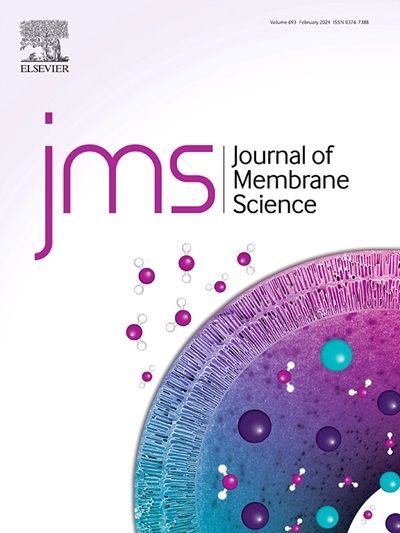“One tube killing two birds”: Simultaneously boosting the separation and mechanical performances of block copolymer membranes by sparsely doping carbon nanotubes
IF 8.4
1区 工程技术
Q1 ENGINEERING, CHEMICAL
引用次数: 0
Abstract
Selective swelling of block copolymers as an emerging process to prepare ultrafiltration membranes is receiving growing interests. Herein, we report that very little dosages of carbon nanotubes (CNTs) are able to significantly enhance both the separation and mechanical performances of melt-spun polysulfone-block-poly(ethylene glycol) (PSF-b-PEG) hollow-fiber membranes. CNTs are adequately dispersed in the block copolymer by melt processing, and exhibit π–π interaction to the PSF continuous phase but repulsion to the PEG dispersed phase. The incompatibility between CNTs and PEG leads to interfacial gaps between CNTs and the PEG phase, thus providing another set of pores facilitating water permeance. Both dosages and aspects of CNTs significantly influence the pore structure and performances of the membranes. Higher dosages of CNTs produce more interfacial gaps and lead to increased porosity and permeance. While CNTs with lower aspects tend to be distributed in the PSF phase, thus producing smaller pores and decreasing permeance by refraining selective swelling to a larger degree. The hollow-fiber membrane doped with 0.01 wt% CNTs having a diameter of ∼10–20 nm and a length of ∼50 μm shows a water permeance increased by three times and a rejection increased by 1.6 times. Moreover, thus-doped membrane exhibits over 1.5 times increase both in tensile stress and the strain at break and multiple times increase in swing tolerance. Such an extremely low dosage of CNTs synchronously boosting membrane permeance, rejection, and mechanical properties is highly desired in practical applications and is expected to be extended in the performance-upgrading of other membranes with multiphases.

求助全文
约1分钟内获得全文
求助全文
来源期刊

Journal of Membrane Science
工程技术-高分子科学
CiteScore
17.10
自引率
17.90%
发文量
1031
审稿时长
2.5 months
期刊介绍:
The Journal of Membrane Science is a publication that focuses on membrane systems and is aimed at academic and industrial chemists, chemical engineers, materials scientists, and membranologists. It publishes original research and reviews on various aspects of membrane transport, membrane formation/structure, fouling, module/process design, and processes/applications. The journal primarily focuses on the structure, function, and performance of non-biological membranes but also includes papers that relate to biological membranes. The Journal of Membrane Science publishes Full Text Papers, State-of-the-Art Reviews, Letters to the Editor, and Perspectives.
 求助内容:
求助内容: 应助结果提醒方式:
应助结果提醒方式:


